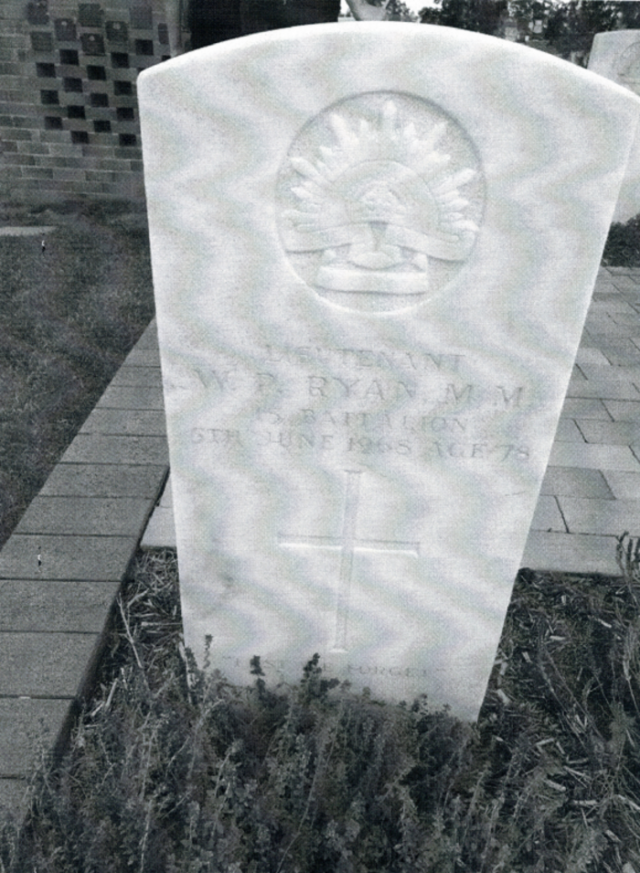By John Telfer, History Columnist
William Patrick Ryan, known as Bill, was born on 23 March 1890 at Warwick Hospital. He was the fourth son of Michael Ryan of Danderoo, near Warwick, Queensland, where his father Michael and grandparents Thomas and Bridget Ryan, were early pioneers of that district. They had taken up farming on arrival there in 1859 from Ireland. Bill’s father became an award-winning corn farmer in the district and was dubbed the “Corn King” of Danderoo in the 1930s, because of his profound knowledge of the maize industry and his numerous successes as an exhibitor. He won numerous awards at the Royal Easter Sydney Show, the Brisbane Exhibition, as well as the Warwick and Toowoomba Shows.
Bill was educated at the small one-teacher Emu Vale primary school in 1895, and later, at the similarly small school at Danderoo. After leaving school at 14 he became a farm labourer until war broke out in 1914. With the patriotic fervour sweeping the country and the presence of travelling Australian Imperial Force recruiting officers in the Warwick area, Bill felt compelled to do his duty for King and Country.
Bill decided to enlist on 18 January 1916, and became a member of the 14th Light Horse Regiment, A Squadron, and received training at Fraser’s Paddock in Brisbane. When the casualties increased in France he fought as an infantry soldier when the Light Horse were diverted to England to bolster Australian forces on the Western Front.
Bill embarked from Sydney with the 15th battalion on board the troop ship HMAT A72 “Beltana” on 13 May 1916. Arriving at Plymouth, England, soon after he was detached from the 3rd Division cavalry to the 15th Battalion on 8 September 1916, but was held back for a while suffering from mumps which was a common complaint among the diggers at this time. On recovery, Bill and the 15th battalion became part of the allied offensive towards the Hindenburg Line and were heavily involved in battles against the Germans in the 3rd battle of Ypres and Passchendaele. The battles were fought in heavy rain and mud which made it hard to bridge the enemy’s barbed wire entanglements.
On 26 September, Bill was part of the heavy fighting around the small village of Zonnebeke near Polygon Wood and the Augustinian Abby there, between June and November in 1917, before suffering a gunshot wound to his side on 1 February 1917 and was hospitalised at the British Red Cross Hospital. It was in this battle at Zonnebeke that Bill, now a Corporal, had his finest hour as an Australian soldier. His bravery under fire saw him awarded the Military Medal which described this action:
“For conspicuous gallantry and devotion to duty in action near Zonnebeke
on 26th September, 1917. He handled his section with great dash and skill
and time after time led his section against enemy posts which were harassing
the advance. He set a fine example to his men, always bright and cheerful
he kept his section well in hand and thus was able on two occasions, to
concentrate all the fire of his section on small enemy parties, and inflicted
heavy casualties on them. His work throughout was most praiseworthy.”
He also came under the notice of Major-General Ewan Sinclair, CB, CMG, DSO Commander of the 4th Australian Division who commented on Bill’s “gallant action in which he led his section during the attack near Zonnebeke on 26 September 1917”.
Bill’s bravery and leadership resulted in him being awarded a field Commission when he was promoted to Lieutenant on 14 April 1918. Shortly after, Bill was wounded again by a gunshot to his abdomen on 24 August 1918, and was invalided back to the Australian General Hospital in London to recover. On 1 July 1919, Bill was returned to Australia on board the HMAT A72 “Beltana” the same ship that he left on in 1916.
After recuperating from his wounds, Bill, like thousands of returned men took a while to readapt to civilian life so worked on the family farm for a while until he applied for a position at the newly created RAAF No 7 Stores Depot at Drayton North, near Toowoomba, as a storeman, in World War 2. Bill remained there all his working life until his retirement in the mid-1950s to live a quiet life in Toowoomba, until his death in 1968.
Bill never married but was predeceased by his four brothers Michael. Thomas, John and James with only sister Ashley (later Mrs Ashley Bradford of Yangan) left. He was a committed catholic and on his death in Warwick on 5 June 1968 at the age of 78, he was honoured by his faith with a requiem mass conducted by his cousin Father Peter Campbell, at St. Mary’s Catholic Church in Warwick. Later, he was interred in the Soldier’s Section of the Warwick cemetery.
William Patrick Ryan was typical of many of the region’s World War 1 soldiers. They did not hesitate to join in thousands to answer the call to duty in that time in 1914. History shows that they were brave and resourceful, which helped to create the legend of mateship and the Anzac spirit that should be eternal in any future pages of Australia’s history. Those who landed at Gallipoli in 1915 were proud to display the ‘A” on their shoulder patch which singled them out as an Anzac veteran and that pride in our military has been built on ever since. Bill Ryan lies at rest in the soldier’s section of Warwick cemetery which I am sure was his choice of interment, and his place on the Tannymorel Memorial should ensure that he will never be forgotten in the region’s history.







